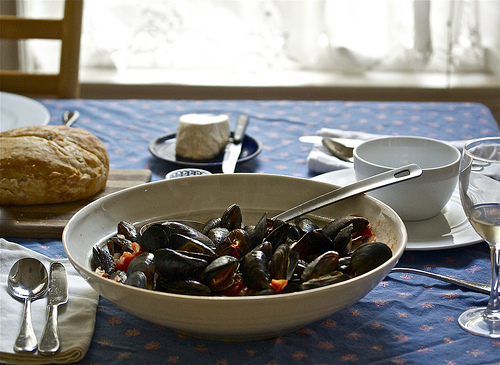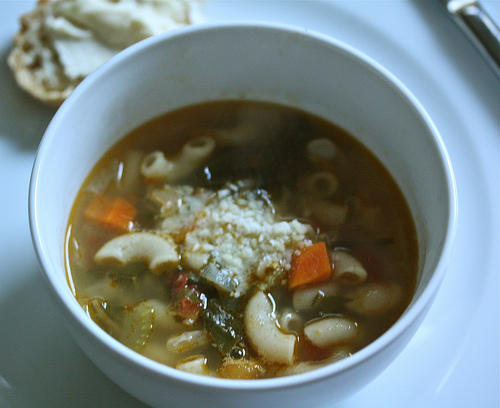
[Dinner, September 2012.]
My parents are currently in Italy for three weeks, taking the long-dreamed-of trip of a lifetime. Of course I had them over for dinner before they left, and of course I cooked mostly Italian recipes. We started with mussels steamed in white wine and then tossed with an oniony tomato sauce, accompanied by homemade bread and butter (I just ate the bread). This was followed by bowls of deliciously rich and brothy minestrone soup and more bread. The main course was just a big heap of fettuccine tossed with tomato sauce (heirloom tomatoes, lots of fresh basil, garlic, and a bit of red wine) and an arugula salad with apple slices and avocado dressed with a lemony vinaigrette. We finished with a vegan tart tatin and scoops of vanilla ice cream – not fully Italian, but nearly so.
Everyone seems to have a ‘how I came to cooking story’, and in truth, mine is not very dramatic. There was no moment of awakening in which I realized I wanted to cook all the things all of the time. I think I was always interested in the kitchen: it seemed the coziest place to be and good things happened there. Maybe it was because when we were kids my brother and I drank our bedtime juice while sitting on the old white linoleum floor, our backs against the cabinets, and it felt clean and safe and right. Or because I always liked to make things: books, sand castles, cookies. I started experimenting with baking earlyish on when my dad started eating healthier (I adapted a lot of recipes to be lower in cholesterol and fat with varying degrees of success) and then moved on to actually cooking meals out of necessity when I had my own kitchen in college. That I enjoyed these endeavors is a side note. It’s all pretty commonplace.
But if I was hard pressed to pinpoint a moment where I ate something that really made me sit up straight and pay attention and start to approach cooking more thoughtfully, it happened in Italy. And not, as you might imagine, in a tucked-away restaurant in Rome or across the street from La Fenice in Venice in a place where I ate the most divine, the most amazing polenta, or or or. Rather, it was in an old farmhouse a few miles from Siena where we ate farm-to-table in the most basic sense of the word (our hosts picked the vegetables just before they made dinner because, well, that’s just how they lived). I have rhapsodized before over the zucchini sauteed in olive oil and basil that culminated in my wee culinary epiphany but even 12 years later I have to say: that zucchini! Who knew simple is best? I guess I didn’t.
I have been thinking about memorable meals lately, and what makes them so: the particular juiciness of a tomato or the first slab of fresh feta that makes you realize all that’s come before it was a poor imitation. One of the reasons I love M.F.K. Fisher so much is because of her ability to write about specific, lovely meals she’d eaten and for her whole-hearted appreciation of them. A certain glass of wine, a dense slab of ginger cake, or tangerine slices left on the windowsill all compelled her to stop and savor the food, and the moment. It’s funny we can remember so vividly foods that touched us years ago — my first tiny cup of Greek coffee, for example — even though they have long since been digested.
I spent a good half-hour last night trying to find that agritourismo I visited in 2000 in colle di val d’elsa, which is in Tuscany. I doubt the family who runs (ran?) it has a website, but it was as if the place has vanished from the ether (and, perhaps also, atmosphere). I like that. I still don’t know how we stumbled upon it – and I mean that in the literal sense; we traveled Europe ‘on the fly’ that summer, finding our lodging day by day (and sometimes night by night) with rarely a plan. Hot, thirsty, and lugging our backpacking backpacks we trudged up a long driveway to a working farm-turned-flopping-place-for-tourists and were grateful to not only learn we could stay for a few nights but we would be fed and feted extremely well – and perhaps my inability to locate it again is sort of perfect. It adds to its mythology in my mind. Was it all a dream? Was I even really there?
We had no car and the family sweetly took us under their collective wing, even dispatching one of the sons to come pick us up after we got lost exploring the medieval village nearby and called ‘home’ in a mini panic. We ate all of our meals there, prepared by Gabriella. Probably in her 70s, she had an inspiring and vigorous energy — and she was an amazing cook. For some reason, though they raised wild boar, the family didn’t eat much meat (she said her sons rarely at meat at all) and so it was not strange that we requested all of our food to be vegetarian. They were so interested in the U.S.; we talked about university and American Indian reservations and California, among other things. We drank watered red wine, dipped bread into homemade olive oil, ate plates of pasta with a deliciously sweet tomato sauce fragrant with garlic.
Of course I can’t remember everything she served, but I will forever remember that zucchini. It was so basic: thinly sliced squash sauteed in a good amount of olive oil and a bit of salt (and sometimes basil) on low heat until very soft — and nothing else. It still remains my favorite way to prepare it, and I think of her (and her shrieking, adorable grandson) nearly every time I do.
So suffice to say I have a soft spot for Italy, and I hope to get back again, more than just one more time even. I also hope my parents are enjoying the heck out of themselves; I’m sure they are.

[Soup of my dreams, September 2012.]
We’ve been sick this week, the kind of sick that fortunately (or unfortunately, depending on how you look at it) does not necessitate staying in bed but still makes you sick enough to feel like eating soup and only soup. Alas, once we finished the minestrone off it was back to quinoa and tofu (but, yum!) and vegetable-brown-rice-Gruyere concoctions (also yum!) and I have been thinking of that soup all week-long, have been fixated on it really. And it’s such a simple thing to make: just garlic, onions, carrots, celery, chard, tomatoes, white beans, a little Parmesan cheese. From minimal ingredients comes true nourishment; this is a soup that cheers the soul (and the immune system).
Today I cried uncle and am working at home so I don’t subject my poor coworkers to any more of my sniffles. I am also making another pot of minestrone, and as I sip my tea the scent of vegetables cooking down into broth is wafting around my apartment, almost making me feel as though I am nearly on the mend. It’s a grey day here in San Francisco – a soup day. A day for wool socks and scarves and the classical station and warm bowls. A day for baking bread and contemplating weekend plans (or no plans). You know the drill.
As a footnote: this recipe comes by way of williams-sonoma.com, a site I’ve been quietly making good use of for years. The recipes are always spot-on and utterly reliable. They are generally unfussy yet still sophisticated – exactly my style of cooking (I like to think, anyway) – and are often full of vegetables and loads of fresh ingredients.

Vegetarian Minestrone Soup, via williams-sonoma.com
For once I cooked the recipe exactly according to the directions, with no real changes except to add a bit of shredded fresh basil because I had some on hand. I would like to gently insist that the Parmesan rind is not ‘optional’ but rather vital, as it adds a tangible richness and depth to the soup. Showering more grated cheese atop your soup bowl is, of course, nice, too.
To make this gluten-free, simply omit the pasta, or use a gluten-free pasta. Simply leaving it out still makes for a pungent, hearty soup.
Makes about 8 generous servings.
For the beans:
1 cup dried cannellini beans
4 large garlic cloves
2 tsp. kosher salt
1 Tbs. extra-virgin olive oil, plus more for drizzling
2 large garlic cloves
2 carrots, peeled and diced
1 small onion, diced
1 celery stalk, thinly sliced
Kosher salt and freshly ground pepper, to taste
1 cup diced fresh or canned tomatoes with their juices
1 bay leaf
2 large fresh sage leaves
2-inch piece Parmigiano-Reggiano cheese rind (optional)
2 cups packed shredded kale or chard
1 cup tubettini or other small dried pasta shape (I used whole wheat macaroni)
Grated Parmigiano-Reggiano cheese for garnish
To cook the beans, pick them over, discarding any that are wrinkled, along with any grit. Place in a bowl, add cold water to cover by 4 inches and soak overnight. Drain the beans, rinse well and transfer to a saucepan. Add the garlic and water to cover by 4 inches. Bring to a gentle boil over high heat, skimming off any foam that forms on the surface. Reduce the heat to medium-low and simmer for 40 minutes. Add the salt and water if needed to keep the beans submerged, and continue to cook until the beans are tender but not mushy, about 30 to 90 minutes more, depending upon the beans. Remove from the heat and let the beans cool in their cooking liquid, then drain, reserving some of the cooking liquid. Set aside. You should have about 2 1/2 cups cooked beans.
Heat a large soup pot over medium-high heat. Add the 1 Tbs. olive oil and the garlic and sauté until the garlic is toasted and the oil is fragrant, about 1 minute. Add the carrots, onion and celery and cook, stirring often, until the vegetables start to soften and brown, 3 to 4 minutes. Season with salt and pepper.
Add the tomatoes, bay leaf, sage, cheese rind and enough water to cover the vegetables by 2 inches and simmer, uncovered, for 30 minutes. Add 2 cups of the cooked beans and the kale and continue to simmer for 20 to 30 minutes. Season with salt and pepper.
Just before the soup is ready, bring a saucepan three-fourths full of salted water to a boil, add the pasta, stir well and cook until al dente (tender but firm to the bite), according to the package instructions. Drain well and divide among warmed soup bowls. Ladle the soup over the pasta, drizzle with olive oil, sprinkle generously with grated cheese and serve. (If you’re not serving 8 people, just dump the rest of the pasta into the soup pot; some of the broth will get soaked up as the soup rests in your fridge. Not to worry: add a bit more water to thin it out as needed.)
How did I miss this?! I LOVE it.
I needed to use the rest of my kale in the garden before planting this winter’s crop. So soup it was – and yummy indeed. I used thyme instead of sage as most of my herbs were destroyed in Isaac.